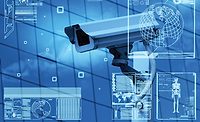
Country Joe McDonald sung his question about war in the 1960s: “It’s 1-2-3, what are we fighting for?” Well, besides freedom and survival and dispatching evil, often one outcome of war is the development of new technology for security and life safety.
World War II developments helped kick off the initial growth of corporate and home electronic security systems. Vietnam spun off perimeter sensors and new types of entrance controls from those many MACV headquarter doors. Now, homeland security and the current threat environment in which we live are creating new innovations with many ending up sooner or later in the quiver of chief security executives and guarding firms.
ROBOTS AND DRONES
There is no better example than drones and robots, only call them unmanned vehicles, the military’s more upscale label.Already war theater ground robots, coupled with ever more powerful sensors, cameras and audio devices, are impacting U.S. law enforcement’s bomb handling needs on numerous city streets, but also business use patrolling from warehouses and ports to industrial site perimeters.
PERSONAL INTERACTION WITH SYSTEMS
How security personnel interact with their devices – communications, computer, video – is important and continues to evolve from matrix joysticks to PCs to Web browsers and in 2-way radios with their push buttons. Then along came touchscreens.But the newest on-the-horizon user interface is the human voice. Driven by the Ford Fiesta with Sync powered by Microsoft and Dragon Systems voice recognition for personal computers and corporate networks, things are getting more accurate, especially in terms of commands that the systems already understand or can learn.
SPEECH RECOGNITION CHALLENGES
Back in 1982, the firms Kurzweil Applied Intelligence and Dragon Systems released speech recognition products. By 1985, Kurzweil’s software had a vocabulary of 1,000 words, if uttered one word at a time. Two years later, its lexicon reached 20,000 words, entering the realm of human vocabularies, which range from 10,000 to 150,000 words. But recognition accuracy was only 10 percent in 1993. Two years later, the error rate crossed below 50 percent. Dragon Systems released “Naturally Speaking” in 1997. It recognized normal human speech. Progress mainly came from improved computer performance and larger source text databases. The Brown Corpus was the first major database available, containing several million words. In 2001 recognition accuracy reached its current plateau of 80 percent, no longer growing with data or computing power. In 2006, Google published a trillion-word corpus, but Carnegie Mellon University researchers found no significant increase in recognition accuracy.TELESCOPE EYES
One experiment comes from Visioncare in which literally a tiny telescope is implanted into people’s eyes to help them see better. The device aims at the partially blind or those suffering from age-related macular degeneration. The telescope implant fixes the blind spots by projecting images on parts of the eye that aren’t damaged.While the future may include RoboCop advances such as the implanted eye telescope, in the meantime some personal visual aids can provide a more reasonable business payback.
Another potential innovation mixes vision with touch.
MATCHING PEOPLE’S THOUGHTS
Devices and systems that determine and adjust to a person’s preferences and feelings are being developed more quickly and successfully than security systems that alert to changes in behavior of people within security images.“I think it’s inevitable,” says Michael Freed, an artificial intelligence specialist and program director at SRI International, which has been studying the concept for the military. “I expect we’ll see a trickle and then a flood.”
The technology is a combination of sophisticated sensors and carefully tailored computer software. As envisioned, the machines adjust their own actions to the preferences and needs of an individual, by analyzing data on the person’s past actions and monitoring current behavior with cameras, audio recorders and other sensors. The design could go beyond what some in the security industry call physical security information management, which is fed corporate and security rules about which to alert. In this next step, security systems learn from the operator, too.
PERSONALIZED VEHICLES
There are numerous other designs and innovations that may one day be displayed at the International Security Conference or ASIS International. What will we see next month at the ASIS Conference in Dallas?Inventor Taizo Doi has a futuristic personal submarine design inspired by the jellyfish. Doi says he wanted the submarine to look like a sea creature. The design includes a 360-degree platform that allows the passengers, presumably tourists, to see the entire ocean at once. But it could also turn into a patrol vehicle at U.S. seaports.
PAINT ON A VISUAL DISPLAY
With command centers demanding larger size video displays, the future may be to paint a big screen right on the wall.
Under development are paint-on liquid crystal displays (LCDs). Liquid crystals are made up of molecules that spontaneously line up, rather than being randomly orientated as in a normal liquid. Passing a voltage across the molecules switches their alignment, blocking the transmission of light so a display changes from light to dark.
In the lab is a so-called open sandwich technique that deposits a layer of liquid crystal onto a single underlying sheet. Working at Eindhoven University of Technology and Philips Research Laboratories in the Netherlands, a research team has produced prototypes on glass and plastic; fabric could be next. The technique could create giant TV screens and slim, plastic LCDs sewn into fabric could display e-mail or text messages on an officer’s sleeve.
Today’s Security “Game Changers”
While future technologies are exciting and often game changers, well, they’re still in the future. We asked several chief security officers and security directors what technology is making a difference in their security operations. From door locks to mini dome cameras to video storage, here’s what they are using.Bernard J. Scaglione, director of security at New York Presbyterian Hospital-Weill Cornell Campus and a principal partner at The Security Design Group: “The new stand alone door lock series (AD Series) from Ingersoll Rand is my pick. The locks are completely interchangeable not only with the access technology they use but they can be modified to be stand alone (battery operated) or be hardwired to IR’s or any access control systems. The great part about these locks is that you buy the base lock and the rest can be changed out by just plugged into the lock body.”
Maria Chadwick, director of surveillance for Wynn | Encore in Las Vegas: “Recently, we have been able to test the new HD3MDIP High Definition Mini Dome from Honeywell. The results are impressive. Honeywell is able to offer high resolution coverage with the same storage requirements as a 4CIF (full 30 frames per second at 2.5 – 3 Mbps) analog camera. This allows us to use our existing storage without having to sacrifice camera coverage quality and added costs. The HD3MDIP’s increased resolution provides crisp details and color definition even in challenging lighting conditions. In turn, it allows me to zoom in and capture high quality close up shots without the loss of video quality, giving me the ability to reduce the amount of required cameras per area.”
Guy Grace, manager of security and emergency planning for the Littleton, Colo. Public Schools: “Radio communications is one of the most challenging issues that a school district faces when it comes to emergencies. Our school district currently uses several types of radio communications systems from campus to campus. All of our schools have at least one radio that can talk to first responders in emergencies. However, the ability to bridge all the radios to communicate to first responders was not possible until now. Under a new enhanced 911 system developed by SchoolSafe Communications, schools can call 911 and be immediately connected with first responders through the school’s existing two-way radios. The SchoolSAFE remote controlled radio bridge allows school security personnel and school staff to communicate and work directly with police and other first responders during a crisis.
Different radio users have different coverage, capacity, functionality needs and therefore require different types of radio systems for their day to day use. Having specialized remote control SchoolSAFE two-way radio bridges in schools gives security and public safety dispatchers the ability to select, activate and de-activate the appropriate interoperable channels.
As a result, school safety teams can more effectively participate in the areas of situation size-up and threat assessment, alert and notification, search and rescue, first aid, evacuation/shelter/care, facilities and security response, crisis intervention, student release, continuity of education and school building reoccupation.
In addition, special emphasis is given to understanding and developing another potential advantage: radio’s dual role in providing other uses that supports an open and nurturing learning environment, while also enhancing the visible security measures where desired, in order to act as a deterrent. One of the enhancements of the system was to take ‘radio call boxes’ and placed them at security card access points at the one of the high schools as a pilot program. What this allows is for the call boxes to be used as communication points for staff access control after hours. The system allows the user at the call box to speak with the District Security Command Center located miles away. You are enhancing the security of the facility by using the box for communication, with the camera and reader for identification. Another possible use would be to utilize the call boxes for guests on school grounds to call security if they need help. Most users of school grounds after hours are children, and over the years I have seen a few emergencies arise where such a communication device would have been very helpful. The device could also be use to warn potential no-gooders that they are being watched. One of the interesting traits we have noticed over the years with our current surveillance technology is that vandalism and other crimes are often not done immediately, in fact the persons responsible often hang around doing other things and then their behavior escalates to the damaging activity. Since we have recognized that trait in our district we have reduced our property crime anywhere from 68-95 percent per site (based upon statistics before the installation of our current integrated security system) by deterring the individuals before things get started basically shooing away the loiters or just being there when suspicious actions are spotted. The technology could potentially even help eliminate property crime even further. Any technology like SchoolSafe that can be utilized in multiple security roles is a nice tool to have.”
Gary Adkins, assistant vice president of security for Sotheby’s Art Auction House: “Intransa’s patented Video Data Management & Retention technology blends integrated server systems and modular, scalable video storage, all part of the Intransa VideoAppliance family. Purpose-built for physical security needs, it is used by Sotheby’s, a global art auction, private sales and art related finance company, to protect its valuable artwork while providing ongoing savings. Located in New York, Sotheby’s installed an Intransa scalable storage system as part of its risk management strategy. The artwork Sotheby’s deals with is worth millions of dollars, which leaves the company constantly challenged from a risk management position. The company cannot have any damage to its artwork, but if it does happen it is better to find out right away, and when they can’t find out right away it’s important that they have video stored weeks and even months out. The New York Sotheby’s office has more than 285 cameras spread over 400,000 square feet on 10 floors. Intransa’s security video records the storage area, exhibition areas, the central receiving area, executive offices and the galleries, in addition to the auction sales floor on the seventh floor. Originally, Sotheby’s was using DVR storage space to store its video. But it prevented the auction house from recording motion and it could not capture the time frame of events that were needed. The Intransa scalable storage system will eventually provide Sotheby’s with one year of video storage on each and every camera in the building. It features storage drives that are installed inside the DVR console to give the organization the storage space it needed. Sotheby’s has an opportunity to build on the system, and by doing so will have enough disk drive space to maintain one year for all 285 cameras. The video is streamed onto Sotheby’s system, so it’s easy for the security department to bring up the stored information/video when needed.”
Bryan Warren CHPA, CPO-I, director, Carolinas HealthCare System Corporate Security: “In no particular order, my top three choices are the Segway personal transporters (pictured) which we have used very successfully for several years now, Bosch Extreme CCTV’s License Plate Capture cameras, and the International Association for Healthcare Security and Safety (IAHSS) Basic Industry Guidelines for HealthCare Security (available to all IAHSS members). Theses guidelines have been of huge assistance in the creation and implementation of many of our policies, procedures and practices and serve as a great reference material for numerous issues.”
John E. McClurg, vice president - Global Security for Honeywell Global Security: “After I took over as the CSO here at Honeywell five years ago, I committed to using only Honeywell products and services whenever possible when it came to both assuring and enhancing the people, processes, and assets by which Honeywell achieves its greater missions. It will not surprise you then when the new, innovative product I’d nominate for consideration in your upcoming article is one that Honeywell recently offered to the community. The Honeywell MAXPRO Video Management System (VMS) integrates video IP and analog cameras, alarm systems, floor plans, and access control to quickly and accurately detect threats and areas of risk. Security professionals use MAXPRO VMS to view feeds from all of their facilities’ cameras on a single screen. It allows companies to network older analog and new digital surveillance technologies. This product can be a real game changer for anyone dealing with a menagerie of disparate legacy systems.
Users can integrate both their Honeywell and non-Honeywell equipment into one video surveillance system. Its easy-to-use features improve operator productivity, cut investigation times and reduce the need to replace old equipment or purchase new equipment in order to integrate systems. It is being used on large, highly populated sites such as airports, seaports, casinos, housing complexes, universities, and healthcare facilities.”
Robert M Ryan CPP, CHPA, director of security & transportation, Children’s Hospital, Boston: “We use the EasyLobby Visitor management system that we put in place about 18 months ago. In the past, we had to use a paper log sheet, to sign people in, making it difficult for example to answer simple questions such as how many visitors did we have last month or last year. Sifting through reams of paper logs to get those answers was time consuming not to mention it did not answer other questions, such as where did they go when they were here? With EasyLobby, we use driver’s license scanning technology and web cam’s to capture not only names but photos of all visitors as well. We know where these people are going, as we can customize fields with building names, department names, floor and photos on the ID itself. Additionally, if we have someone that is barred from the property, there is an alert section where we can place names and photos with special instructions should a person on the alert list show up. Finally, we are working with EasyLobby and our security system platform Lenel, to integrate those 2 platforms. We are close to implementing bar code technology, so that a Temporary visitor or parent ID badge, generated in EasyLobby can be read and understood by card readers in the Lenel system. This will give visitors or parents elevator and floor access. By using a cheap, paper, self expiring ID badge, vs. issuing them a much more expensive proximity card, that we most likely would not get back. This undertaking will enable us to lock elevators and individual floors, yet allow ‘authorized’ individuals to access those areas with a badge.”
Al Segal, director of security for Williamson Medical Center in Franklin, Tenn. “We now have more than 130 card readers on our campus and approximately 5,000 Keyscan ID cardholders in our system. Our mobile security personal have full access to Keysan from our security vehicle. They can lock the hospital down within minutes or just open a door for a vendor. They observe all users as the user’s picture; name and other information pop up on the computer screen every time the card is used. I attribute a major portion of our hospital’s safety record to the ability to properly control campus access through Keyscan Access Control.”



